这篇文章主要介绍“Android audio音频流数据异常问题怎么解决”的相关知识,小编通过实际案例向大家展示操作过程,操作方法简单快捷,实用性强,希望这篇“Android audio音频流数据异常问题怎么解决”文章能帮助大家解决问题。
在 Android 系统的开发过程当中,音频异常问题通常有如下几类,无声,调节不了声音,爆音,声音卡顿,声音效果异常(忽大忽小,低音缺失等)等。
尤其声音效果这部分问题通常从日志上信息量较少,相对难定位根因。想要分析此类问题,便需要对声音传输链路有一定的了解,能够在链路中对各节点的音频流进行采集,通过对比分析音频流的实际效果来缩小问题范围,找出原因。
网上已经有很多音频框架图和相关的大致介绍,这里就不再赘述,只分享下音频流的传输链路,和我们可以重点其中的哪些关键节点,来帮助我们快速定位问题。
抓取音频链路当中的音频数据是分析声音异常问题的有效方法,通过抓取不同节点的声音数据,可以帮助我们快速定位问题发生的原因。下面先来看一张安卓官方的音频系统框架图:
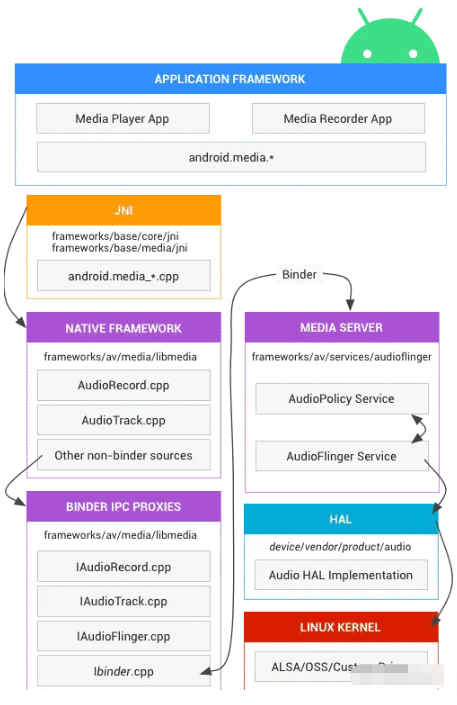
Audio 音频数据流整体上经过 APP,framework,hal,kernel driver四个部分,从应用端发起,不管调用 audio 还是 media 接口,最终还是会由 AudioTrack 将数据往下传,经由 AudioFlinger 启动 MixThread 或 DirectThread 等,将多个 APP 的声音混合到一起,将声音传输到 hal 层。
系统会根据音频流类型 stream 和音频策略 strategy 来选择对应的 output,从而找到对应的 module,将音频数据传输给 hal 层音频库 so 做声音相关的处理并传给 audio driver。
音频流传输路径图:
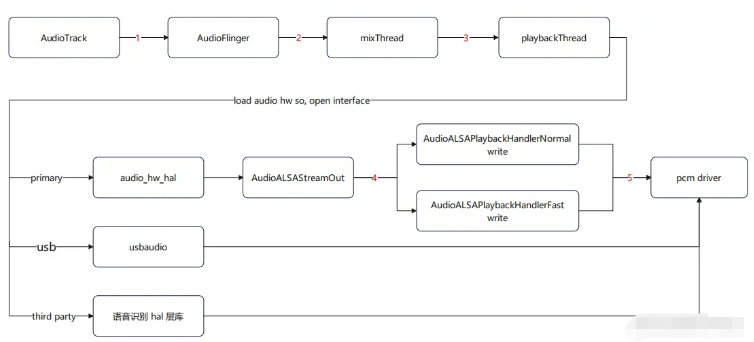
从上述的音频流流程可以看到,我们首先要确认,当前音频流是经由哪一个 hal 层库做处理,是 primary,usb 还是三方 so 等,然后可以在对应的节点抓取相应的音频信息分析。
可以根据自己的需要在音频流的部分节点埋下相应的 dump 指令,将 pcm 写入到相应的节点当中。
  AudioTrack:应用写入音频流的起点,有 MODE_STATIC 和 MODE_STREAM 模式,通过 write 接口将数据写入。
此节点写入的数据是由应用层最原始的音频数据。   
AudioFlinger:负责启动线程完成各个应用的混音,音频流声音调节等工作。设备同时可能存在多个应用播放声音,这时便需要将各个应用的声音混合在一起,并且做音量的调节。
例如在车载场景中,音乐应用播放歌曲和地图应用语音导航的声音需要同时存在,便使用到了混音的功能,当导航语音响起时,歌曲声音有一个明显的变小,便可以设置音频流的音量。   
audio_hw_hal:hal 层音频处理的入口,为 Android 原生逻辑,各厂家需要按照规范实现其中的音频设置等接口,声明 HAL_MODULE_INFO_SYM 结构体,实现 legacy_adev_open 方法,承接起连接 framework 和 audio driver 的作用,完成一些音效算法等逻辑处理。
AudioStreamOut:和 audio_hw_hal 一样,是Android 给厂家提供的通用类,厂家在实现自己的通用库实现时需要可以按照谷歌规范,然后在相应的音频处理接口中实现自己的对音频流做音效,增益等处理。
audio_hw_hal.cpp 代码如下,不同厂家这里的实现略有差异,这里只截取部分 AOSP 源码。
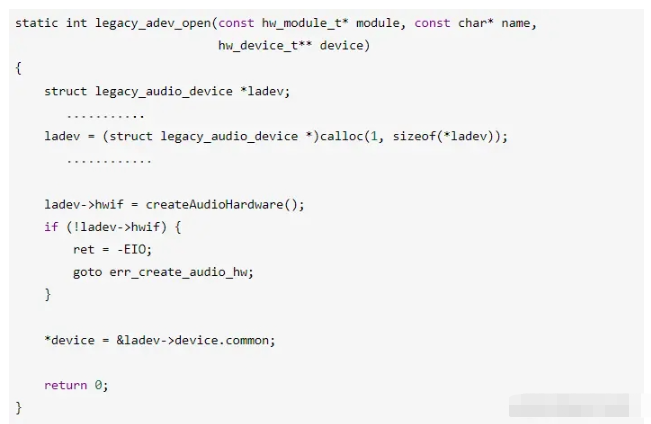
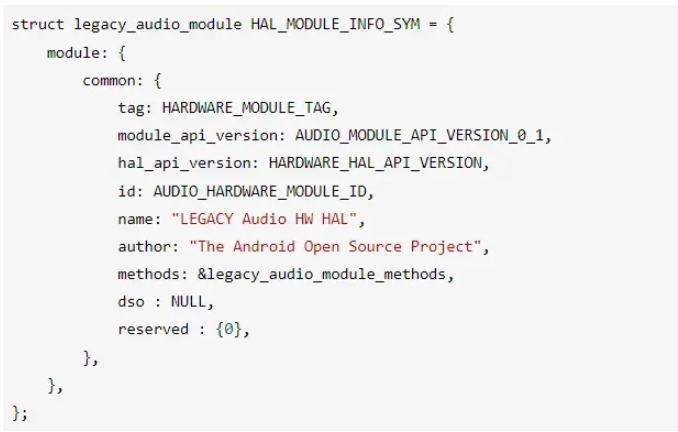
从音频流传输路径图可以看到,如何找到是哪一个音频 so 处理声音也是至关重要的。我们知道,系统对于应用层曝光的其实只有通道类型。
举个例子:当用户打电话时,可以使用通话通道 STREAM_VOICE_CALL,当用户播放视频时,可以使用媒体通道 STREAM_MUSIC,当发送通知时,可以使用 STREAM_NOTIFICATION。
那传入这些通道的声音数据,又是怎么最终流向到具体的硬件输出设备呢?

以媒体通道为例,当应用层将音频数据往 MUSIC 通道写入时,系统便会根据 StreamType 来生成相应的
audio_attributes_t(.usage = AUDIO_USAGE_MEDIA, .content_type = AUDIO_CONTENT_TYPE_MUSIC})
再通过 audio_attributes_t 来获取对应的 ProductStrategy(STRATEGY_MEDIA),最后在拿到对应的 outputDevice。
Android 原生逻辑outputDevice 的选择在 Engine.cpp 上,会具体根据当前设备是否有接蓝牙,耳机等外设,按照优先级来选择相应的外设设备作为输出,可能是耳机 (AUDIO_DEVICE_OUT_WIRED_HEADSET),听筒(AUDIO_DEVICE_OUT_EARPIECE),喇叭(AUDIO_DEVICE_OUT_SPEAKER)等。
具体可以看 getDeviceForStrategyInt 方法。
/*
* Copyright (C) 2015 The Android Open Source Project
*
* Licensed under the Apache License, Version 2.0 (the "License");
* you may not use this file except in compliance with the License.
* You may obtain a copy of the License at
*
* http://www.apache.org/licenses/LICENSE-2.0
*
* Unless required by applicable law or agreed to in writing, software
* distributed under the License is distributed on an "AS IS" BASIS,
* WITHOUT WARRANTIES OR CONDITIONS OF ANY KIND, either express or implied.
* See the License for the specific language governing permissions and
* limitations under the License.
*/
#define LOG_TAG "APM::AudioPolicyEngine"
//#define LOG_NDEBUG 0
//#define VERY_VERBOSE_LOGGING
#ifdef VERY_VERBOSE_LOGGING
#define ALOGVV ALOGV
#else
#define ALOGVV(a...) do { } while(0)
#endif
#include "Engine.h"
#include <AudioPolicyManagerObserver.h>
#include <AudioPort.h>
#include <IOProfile.h>
#include <policy.h>
#include <utils/String8.h>
#include <utils/Log.h>
namespace android
{
namespace audio_policy
{
Engine::Engine()
: mManagerInterface(this),
mPhoneState(AUDIO_MODE_NORMAL),
mApmObserver(NULL)
{
for (int i = 0; i < AUDIO_POLICY_FORCE_USE_CNT; i++) {
mForceUse[i] = AUDIO_POLICY_FORCE_NONE;
}
}
Engine::~Engine()
{
}
void Engine::setObserver(AudioPolicyManagerObserver *observer)
{
ALOG_ASSERT(observer != NULL, "Invalid Audio Policy Manager observer");
mApmObserver = observer;
}
status_t Engine::initCheck()
{
return (mApmObserver != NULL) ? NO_ERROR : NO_INIT;
}
status_t Engine::setPhoneState(audio_mode_t state)
{
ALOGV("setPhoneState() state %d", state);
if (state < 0 || state >= AUDIO_MODE_CNT) {
ALOGW("setPhoneState() invalid state %d", state);
return BAD_VALUE;
}
if (state == mPhoneState ) {
ALOGW("setPhoneState() setting same state %d", state);
return BAD_VALUE;
}
// store previous phone state for management of sonification strategy below
int oldState = mPhoneState;
mPhoneState = state;
if (!is_state_in_call(oldState) && is_state_in_call(state)) {
ALOGV(" Entering call in setPhoneState()");
mApmObserver->getVolumeCurves().switchVolumeCurve(AUDIO_STREAM_VOICE_CALL,
AUDIO_STREAM_DTMF);
} else if (is_state_in_call(oldState) && !is_state_in_call(state)) {
ALOGV(" Exiting call in setPhoneState()");
mApmObserver->getVolumeCurves().restoreOriginVolumeCurve(AUDIO_STREAM_DTMF);
}
return NO_ERROR;
}
status_t Engine::setForceUse(audio_policy_force_use_t usage, audio_policy_forced_cfg_t config)
{
switch(usage) {
case AUDIO_POLICY_FORCE_FOR_COMMUNICATION:
if (config != AUDIO_POLICY_FORCE_SPEAKER && config != AUDIO_POLICY_FORCE_BT_SCO &&
config != AUDIO_POLICY_FORCE_NONE) {
ALOGW("setForceUse() invalid config %d for FOR_COMMUNICATION", config);
return BAD_VALUE;
}
mForceUse[usage] = config;
break;
case AUDIO_POLICY_FORCE_FOR_MEDIA:
if (config != AUDIO_POLICY_FORCE_HEADPHONES && config != AUDIO_POLICY_FORCE_BT_A2DP &&
config != AUDIO_POLICY_FORCE_WIRED_ACCESSORY &&
config != AUDIO_POLICY_FORCE_ANALOG_DOCK &&
config != AUDIO_POLICY_FORCE_DIGITAL_DOCK && config != AUDIO_POLICY_FORCE_NONE &&
config != AUDIO_POLICY_FORCE_NO_BT_A2DP && config != AUDIO_POLICY_FORCE_SPEAKER ) {
ALOGW("setForceUse() invalid config %d for FOR_MEDIA", config);
return BAD_VALUE;
}
mForceUse[usage] = config;
break;
case AUDIO_POLICY_FORCE_FOR_RECORD:
if (config != AUDIO_POLICY_FORCE_BT_SCO && config != AUDIO_POLICY_FORCE_WIRED_ACCESSORY &&
config != AUDIO_POLICY_FORCE_NONE) {
ALOGW("setForceUse() invalid config %d for FOR_RECORD", config);
return BAD_VALUE;
}
mForceUse[usage] = config;
break;
case AUDIO_POLICY_FORCE_FOR_DOCK:
if (config != AUDIO_POLICY_FORCE_NONE && config != AUDIO_POLICY_FORCE_BT_CAR_DOCK &&
config != AUDIO_POLICY_FORCE_BT_DESK_DOCK &&
config != AUDIO_POLICY_FORCE_WIRED_ACCESSORY &&
config != AUDIO_POLICY_FORCE_ANALOG_DOCK &&
config != AUDIO_POLICY_FORCE_DIGITAL_DOCK) {
ALOGW("setForceUse() invalid config %d for FOR_DOCK", config);
}
mForceUse[usage] = config;
break;
case AUDIO_POLICY_FORCE_FOR_SYSTEM:
if (config != AUDIO_POLICY_FORCE_NONE &&
config != AUDIO_POLICY_FORCE_SYSTEM_ENFORCED) {
ALOGW("setForceUse() invalid config %d for FOR_SYSTEM", config);
}
mForceUse[usage] = config;
break;
case AUDIO_POLICY_FORCE_FOR_HDMI_SYSTEM_AUDIO:
if (config != AUDIO_POLICY_FORCE_NONE &&
config != AUDIO_POLICY_FORCE_HDMI_SYSTEM_AUDIO_ENFORCED) {
ALOGW("setForceUse() invalid config %d for HDMI_SYSTEM_AUDIO", config);
}
mForceUse[usage] = config;
break;
case AUDIO_POLICY_FORCE_FOR_ENCODED_SURROUND:
if (config != AUDIO_POLICY_FORCE_NONE &&
config != AUDIO_POLICY_FORCE_ENCODED_SURROUND_NEVER &&
config != AUDIO_POLICY_FORCE_ENCODED_SURROUND_ALWAYS &&
config != AUDIO_POLICY_FORCE_ENCODED_SURROUND_MANUAL) {
ALOGW("setForceUse() invalid config %d for ENCODED_SURROUND", config);
return BAD_VALUE;
}
mForceUse[usage] = config;
break;
case AUDIO_POLICY_FORCE_FOR_VIBRATE_RINGING:
if (config != AUDIO_POLICY_FORCE_BT_SCO && config != AUDIO_POLICY_FORCE_NONE) {
ALOGW("setForceUse() invalid config %d for FOR_VIBRATE_RINGING", config);
return BAD_VALUE;
}
mForceUse[usage] = config;
break;
default:
ALOGW("setForceUse() invalid usage %d", usage);
break; // TODO return BAD_VALUE?
}
return NO_ERROR;
}
routing_strategy Engine::getStrategyForStream(audio_stream_type_t stream)
{
// stream to strategy mapping
switch (stream) {
case AUDIO_STREAM_VOICE_CALL:
case AUDIO_STREAM_BLUETOOTH_SCO:
return STRATEGY_PHONE;
case AUDIO_STREAM_RING:
case AUDIO_STREAM_ALARM:
return STRATEGY_SONIFICATION;
case AUDIO_STREAM_NOTIFICATION:
return STRATEGY_SONIFICATION_RESPECTFUL;
case AUDIO_STREAM_DTMF:
return STRATEGY_DTMF;
default:
ALOGE("unknown stream type %d", stream);
case AUDIO_STREAM_SYSTEM:
// NOTE: SYSTEM stream uses MEDIA strategy because muting music and switching outputs
// while key clicks are played produces a poor result
case AUDIO_STREAM_MUSIC:
return STRATEGY_MEDIA;
case AUDIO_STREAM_ENFORCED_AUDIBLE:
return STRATEGY_ENFORCED_AUDIBLE;
case AUDIO_STREAM_TTS:
return STRATEGY_TRANSMITTED_THROUGH_SPEAKER;
case AUDIO_STREAM_ACCESSIBILITY:
return STRATEGY_ACCESSIBILITY;
case AUDIO_STREAM_REROUTING:
return STRATEGY_REROUTING;
}
}
routing_strategy Engine::getStrategyForUsage(audio_usage_t usage)
{
// usage to strategy mapping
switch (usage) {
case AUDIO_USAGE_ASSISTANCE_ACCESSIBILITY:
return STRATEGY_ACCESSIBILITY;
case AUDIO_USAGE_MEDIA:
case AUDIO_USAGE_GAME:
case AUDIO_USAGE_ASSISTANT:
case AUDIO_USAGE_ASSISTANCE_NAVIGATION_GUIDANCE:
case AUDIO_USAGE_ASSISTANCE_SONIFICATION:
return STRATEGY_MEDIA;
case AUDIO_USAGE_VOICE_COMMUNICATION:
return STRATEGY_PHONE;
case AUDIO_USAGE_VOICE_COMMUNICATION_SIGNALLING:
return STRATEGY_DTMF;
case AUDIO_USAGE_ALARM:
case AUDIO_USAGE_NOTIFICATION_TELEPHONY_RINGTONE:
return STRATEGY_SONIFICATION;
case AUDIO_USAGE_NOTIFICATION:
case AUDIO_USAGE_NOTIFICATION_COMMUNICATION_REQUEST:
case AUDIO_USAGE_NOTIFICATION_COMMUNICATION_INSTANT:
case AUDIO_USAGE_NOTIFICATION_COMMUNICATION_DELAYED:
case AUDIO_USAGE_NOTIFICATION_EVENT:
return STRATEGY_SONIFICATION_RESPECTFUL;
case AUDIO_USAGE_UNKNOWN:
default:
return STRATEGY_MEDIA;
}
}
audio_devices_t Engine::getDeviceForStrategy(routing_strategy strategy) const
{
DeviceVector availableOutputDevices = mApmObserver->getAvailableOutputDevices();
DeviceVector availableInputDevices = mApmObserver->getAvailableInputDevices();
const SwAudioOutputCollection &outputs = mApmObserver->getOutputs();
return getDeviceForStrategyInt(strategy, availableOutputDevices,
availableInputDevices, outputs, (uint32_t)AUDIO_DEVICE_NONE);
}
audio_devices_t Engine::getDeviceForStrategyInt(routing_strategy strategy,
DeviceVector availableOutputDevices,
DeviceVector availableInputDevices,
const SwAudioOutputCollection &outputs,
uint32_t outputDeviceTypesToIgnore) const
{
uint32_t device = AUDIO_DEVICE_NONE;
uint32_t availableOutputDevicesType =
availableOutputDevices.types() & ~outputDeviceTypesToIgnore;
switch (strategy) {
case STRATEGY_TRANSMITTED_THROUGH_SPEAKER:
device = availableOutputDevicesType & AUDIO_DEVICE_OUT_SPEAKER;
break;
case STRATEGY_SONIFICATION_RESPECTFUL:
if (isInCall() || outputs.isStreamActiveLocally(AUDIO_STREAM_VOICE_CALL)) {
device = getDeviceForStrategyInt(
STRATEGY_SONIFICATION, availableOutputDevices, availableInputDevices, outputs,
outputDeviceTypesToIgnore);
} else {
bool media_active_locally =
outputs.isStreamActiveLocally(
AUDIO_STREAM_MUSIC, SONIFICATION_RESPECTFUL_AFTER_MUSIC_DELAY)
|| outputs.isStreamActiveLocally(
AUDIO_STREAM_ACCESSIBILITY, SONIFICATION_RESPECTFUL_AFTER_MUSIC_DELAY);
// routing is same as media without the "remote" device
device = getDeviceForStrategyInt(STRATEGY_MEDIA,
availableOutputDevices,
availableInputDevices, outputs,
AUDIO_DEVICE_OUT_REMOTE_SUBMIX | outputDeviceTypesToIgnore);
// if no media is playing on the device, check for mandatory use of "safe" speaker
// when media would have played on speaker, and the safe speaker path is available
if (!media_active_locally
&& (device & AUDIO_DEVICE_OUT_SPEAKER)
&& (availableOutputDevicesType & AUDIO_DEVICE_OUT_SPEAKER_SAFE)) {
device |= AUDIO_DEVICE_OUT_SPEAKER_SAFE;
device &= ~AUDIO_DEVICE_OUT_SPEAKER;
}
}
break;
case STRATEGY_DTMF:
if (!isInCall()) {
// when off call, DTMF strategy follows the same rules as MEDIA strategy
device = getDeviceForStrategyInt(
STRATEGY_MEDIA, availableOutputDevices, availableInputDevices, outputs,
outputDeviceTypesToIgnore);
break;
}
// when in call, DTMF and PHONE strategies follow the same rules
// FALL THROUGH
case STRATEGY_PHONE:
// Force use of only devices on primary output if:
// - in call AND
// - cannot route from voice call RX OR
// - audio HAL version is < 3.0 and TX device is on the primary HW module
if (getPhoneState() == AUDIO_MODE_IN_CALL) {
audio_devices_t txDevice = getDeviceForInputSource(AUDIO_SOURCE_VOICE_COMMUNICATION);
sp<AudioOutputDescriptor> primaryOutput = outputs.getPrimaryOutput();
audio_devices_t availPrimaryInputDevices =
availableInputDevices.getDevicesFromHwModule(primaryOutput->getModuleHandle());
// TODO: getPrimaryOutput return only devices from first module in
// audio_policy_configuration.xml, hearing aid is not there, but it's
// a primary device
// FIXME: this is not the right way of solving this problem
audio_devices_t availPrimaryOutputDevices =
(primaryOutput->supportedDevices() | AUDIO_DEVICE_OUT_HEARING_AID) &
availableOutputDevices.types();
if (((availableInputDevices.types() &
AUDIO_DEVICE_IN_TELEPHONY_RX & ~AUDIO_DEVICE_BIT_IN) == 0) ||
(((txDevice & availPrimaryInputDevices & ~AUDIO_DEVICE_BIT_IN) != 0) &&
(primaryOutput->getAudioPort()->getModuleVersionMajor() < 3))) {
availableOutputDevicesType = availPrimaryOutputDevices;
}
}
// for phone strategy, we first consider the forced use and then the available devices by
// order of priority
switch (mForceUse[AUDIO_POLICY_FORCE_FOR_COMMUNICATION]) {
case AUDIO_POLICY_FORCE_BT_SCO:
if (!isInCall() || strategy != STRATEGY_DTMF) {
device = availableOutputDevicesType & AUDIO_DEVICE_OUT_BLUETOOTH_SCO_CARKIT;
if (device) break;
}
device = availableOutputDevicesType & AUDIO_DEVICE_OUT_BLUETOOTH_SCO_HEADSET;
if (device) break;
device = availableOutputDevicesType & AUDIO_DEVICE_OUT_BLUETOOTH_SCO;
if (device) break;
// if SCO device is requested but no SCO device is available, fall back to default case
// FALL THROUGH
default: // FORCE_NONE
device = availableOutputDevicesType & AUDIO_DEVICE_OUT_HEARING_AID;
if (device) break;
// when not in a phone call, phone strategy should route STREAM_VOICE_CALL to A2DP
if (!isInCall() &&
(mForceUse[AUDIO_POLICY_FORCE_FOR_MEDIA] != AUDIO_POLICY_FORCE_NO_BT_A2DP) &&
outputs.isA2dpSupported()) {
device = availableOutputDevicesType & AUDIO_DEVICE_OUT_BLUETOOTH_A2DP;
if (device) break;
device = availableOutputDevicesType & AUDIO_DEVICE_OUT_BLUETOOTH_A2DP_HEADPHONES;
if (device) break;
}
device = availableOutputDevicesType & AUDIO_DEVICE_OUT_WIRED_HEADPHONE;
if (device) break;
device = availableOutputDevicesType & AUDIO_DEVICE_OUT_WIRED_HEADSET;
if (device) break;
device = availableOutputDevicesType & AUDIO_DEVICE_OUT_LINE;
if (device) break;
device = availableOutputDevicesType & AUDIO_DEVICE_OUT_USB_HEADSET;
if (device) break;
device = availableOutputDevicesType & AUDIO_DEVICE_OUT_USB_DEVICE;
if (device) break;
if (!isInCall()) {
device = availableOutputDevicesType & AUDIO_DEVICE_OUT_USB_ACCESSORY;
if (device) break;
device = availableOutputDevicesType & AUDIO_DEVICE_OUT_DGTL_DOCK_HEADSET;
if (device) break;
device = availableOutputDevicesType & AUDIO_DEVICE_OUT_AUX_DIGITAL;
if (device) break;
device = availableOutputDevicesType & AUDIO_DEVICE_OUT_ANLG_DOCK_HEADSET;
if (device) break;
}
device = availableOutputDevicesType & AUDIO_DEVICE_OUT_EARPIECE;
break;
case AUDIO_POLICY_FORCE_SPEAKER:
// when not in a phone call, phone strategy should route STREAM_VOICE_CALL to
// A2DP speaker when forcing to speaker output
if (!isInCall() &&
(mForceUse[AUDIO_POLICY_FORCE_FOR_MEDIA] != AUDIO_POLICY_FORCE_NO_BT_A2DP) &&
outputs.isA2dpSupported()) {
device = availableOutputDevicesType & AUDIO_DEVICE_OUT_BLUETOOTH_A2DP_SPEAKER;
if (device) break;
}
if (!isInCall()) {
device = availableOutputDevicesType & AUDIO_DEVICE_OUT_USB_ACCESSORY;
if (device) break;
device = availableOutputDevicesType & AUDIO_DEVICE_OUT_USB_DEVICE;
if (device) break;
device = availableOutputDevicesType & AUDIO_DEVICE_OUT_DGTL_DOCK_HEADSET;
if (device) break;
device = availableOutputDevicesType & AUDIO_DEVICE_OUT_AUX_DIGITAL;
if (device) break;
device = availableOutputDevicesType & AUDIO_DEVICE_OUT_ANLG_DOCK_HEADSET;
if (device) break;
}
device = availableOutputDevicesType & AUDIO_DEVICE_OUT_SPEAKER;
break;
}
break;
case STRATEGY_SONIFICATION:
// If incall, just select the STRATEGY_PHONE device: The rest of the behavior is handled by
// handleIncallSonification().
if (isInCall() || outputs.isStreamActiveLocally(AUDIO_STREAM_VOICE_CALL)) {
device = getDeviceForStrategyInt(
STRATEGY_PHONE, availableOutputDevices, availableInputDevices, outputs,
outputDeviceTypesToIgnore);
break;
}
// FALL THROUGH
case STRATEGY_ENFORCED_AUDIBLE:
// strategy STRATEGY_ENFORCED_AUDIBLE uses same routing policy as STRATEGY_SONIFICATION
// except:
// - when in call where it doesn't default to STRATEGY_PHONE behavior
// - in countries where not enforced in which case it follows STRATEGY_MEDIA
if ((strategy == STRATEGY_SONIFICATION) ||
(mForceUse[AUDIO_POLICY_FORCE_FOR_SYSTEM] == AUDIO_POLICY_FORCE_SYSTEM_ENFORCED)) {
device = availableOutputDevicesType & AUDIO_DEVICE_OUT_SPEAKER;
}
// if SCO headset is connected and we are told to use it, play ringtone over
// speaker and BT SCO
if ((availableOutputDevicesType & AUDIO_DEVICE_OUT_ALL_SCO) != 0) {
uint32_t device2 = AUDIO_DEVICE_NONE;
device2 = availableOutputDevicesType & AUDIO_DEVICE_OUT_BLUETOOTH_SCO_CARKIT;
if (device2 == AUDIO_DEVICE_NONE) {
device2 = availableOutputDevicesType & AUDIO_DEVICE_OUT_BLUETOOTH_SCO_HEADSET;
}
if (device2 == AUDIO_DEVICE_NONE) {
device2 = availableOutputDevicesType & AUDIO_DEVICE_OUT_BLUETOOTH_SCO;
}
// Use ONLY Bluetooth SCO output when ringing in vibration mode
if (!((mForceUse[AUDIO_POLICY_FORCE_FOR_SYSTEM] == AUDIO_POLICY_FORCE_SYSTEM_ENFORCED)
&& (strategy == STRATEGY_ENFORCED_AUDIBLE))) {
if (mForceUse[AUDIO_POLICY_FORCE_FOR_VIBRATE_RINGING]
== AUDIO_POLICY_FORCE_BT_SCO) {
if (device2 != AUDIO_DEVICE_NONE) {
device = device2;
break;
}
}
}
// Use both Bluetooth SCO and phone default output when ringing in normal mode
if (mForceUse[AUDIO_POLICY_FORCE_FOR_COMMUNICATION] == AUDIO_POLICY_FORCE_BT_SCO) {
if ((strategy == STRATEGY_SONIFICATION) &&
(device & AUDIO_DEVICE_OUT_SPEAKER) &&
(availableOutputDevicesType & AUDIO_DEVICE_OUT_SPEAKER_SAFE)) {
device |= AUDIO_DEVICE_OUT_SPEAKER_SAFE;
device &= ~AUDIO_DEVICE_OUT_SPEAKER;
}
if (device2 != AUDIO_DEVICE_NONE) {
device |= device2;
break;
}
}
}
// The second device used for sonification is the same as the device used by media strategy
// FALL THROUGH
case STRATEGY_ACCESSIBILITY:
if (strategy == STRATEGY_ACCESSIBILITY) {
// do not route accessibility prompts to a digital output currently configured with a
// compressed format as they would likely not be mixed and dropped.
for (size_t i = 0; i < outputs.size(); i++) {
sp<AudioOutputDescriptor> desc = outputs.valueAt(i);
audio_devices_t devices = desc->device() &
(AUDIO_DEVICE_OUT_HDMI | AUDIO_DEVICE_OUT_SPDIF | AUDIO_DEVICE_OUT_HDMI_ARC);
if (desc->isActive() && !audio_is_linear_pcm(desc->mFormat) &&
devices != AUDIO_DEVICE_NONE) {
availableOutputDevicesType = availableOutputDevices.types() & ~devices;
}
}
availableOutputDevices =
availableOutputDevices.getDevicesFromType(availableOutputDevicesType);
if (outputs.isStreamActive(AUDIO_STREAM_RING) ||
outputs.isStreamActive(AUDIO_STREAM_ALARM)) {
return getDeviceForStrategyInt(
STRATEGY_SONIFICATION, availableOutputDevices, availableInputDevices, outputs,
outputDeviceTypesToIgnore);
}
if (isInCall()) {
return getDeviceForStrategyInt(
STRATEGY_PHONE, availableOutputDevices, availableInputDevices, outputs,
outputDeviceTypesToIgnore);
}
}
// For other cases, STRATEGY_ACCESSIBILITY behaves like STRATEGY_MEDIA
// FALL THROUGH
// FIXME: STRATEGY_REROUTING follow STRATEGY_MEDIA for now
case STRATEGY_REROUTING:
case STRATEGY_MEDIA: {
uint32_t device2 = AUDIO_DEVICE_NONE;
if (strategy != STRATEGY_SONIFICATION) {
// no sonification on remote submix (e.g. WFD)
if (availableOutputDevices.getDevice(AUDIO_DEVICE_OUT_REMOTE_SUBMIX,
String8("0")) != 0) {
device2 = availableOutputDevices.types() & AUDIO_DEVICE_OUT_REMOTE_SUBMIX;
}
}
if (isInCall() && (strategy == STRATEGY_MEDIA)) {
device = getDeviceForStrategyInt(
STRATEGY_PHONE, availableOutputDevices, availableInputDevices, outputs,
outputDeviceTypesToIgnore);
break;
}
if (device2 == AUDIO_DEVICE_NONE) {
device2 = availableOutputDevicesType & AUDIO_DEVICE_OUT_HEARING_AID;
}
if ((device2 == AUDIO_DEVICE_NONE) &&
(mForceUse[AUDIO_POLICY_FORCE_FOR_MEDIA] != AUDIO_POLICY_FORCE_NO_BT_A2DP) &&
outputs.isA2dpSupported()) {
device2 = availableOutputDevicesType & AUDIO_DEVICE_OUT_BLUETOOTH_A2DP;
if (device2 == AUDIO_DEVICE_NONE) {
device2 = availableOutputDevicesType & AUDIO_DEVICE_OUT_BLUETOOTH_A2DP_HEADPHONES;
}
if (device2 == AUDIO_DEVICE_NONE) {
device2 = availableOutputDevicesType & AUDIO_DEVICE_OUT_BLUETOOTH_A2DP_SPEAKER;
}
}
if ((device2 == AUDIO_DEVICE_NONE) &&
(mForceUse[AUDIO_POLICY_FORCE_FOR_MEDIA] == AUDIO_POLICY_FORCE_SPEAKER)) {
device2 = availableOutputDevicesType & AUDIO_DEVICE_OUT_SPEAKER;
}
if (device2 == AUDIO_DEVICE_NONE) {
device2 = availableOutputDevicesType & AUDIO_DEVICE_OUT_WIRED_HEADPHONE;
}
if (device2 == AUDIO_DEVICE_NONE) {
device2 = availableOutputDevicesType & AUDIO_DEVICE_OUT_LINE;
}
if (device2 == AUDIO_DEVICE_NONE) {
device2 = availableOutputDevicesType & AUDIO_DEVICE_OUT_WIRED_HEADSET;
}
if (device2 == AUDIO_DEVICE_NONE) {
device2 = availableOutputDevicesType & AUDIO_DEVICE_OUT_USB_HEADSET;
}
if (device2 == AUDIO_DEVICE_NONE) {
device2 = availableOutputDevicesType & AUDIO_DEVICE_OUT_USB_ACCESSORY;
}
if (device2 == AUDIO_DEVICE_NONE) {
device2 = availableOutputDevicesType & AUDIO_DEVICE_OUT_USB_DEVICE;
}
if (device2 == AUDIO_DEVICE_NONE) {
device2 = availableOutputDevicesType & AUDIO_DEVICE_OUT_DGTL_DOCK_HEADSET;
}
if ((device2 == AUDIO_DEVICE_NONE) && (strategy != STRATEGY_SONIFICATION)) {
// no sonification on aux digital (e.g. HDMI)
device2 = availableOutputDevicesType & AUDIO_DEVICE_OUT_AUX_DIGITAL;
}
if ((device2 == AUDIO_DEVICE_NONE) &&
(mForceUse[AUDIO_POLICY_FORCE_FOR_DOCK] == AUDIO_POLICY_FORCE_ANALOG_DOCK)) {
device2 = availableOutputDevicesType & AUDIO_DEVICE_OUT_ANLG_DOCK_HEADSET;
}
if (device2 == AUDIO_DEVICE_NONE) {
device2 = availableOutputDevicesType & AUDIO_DEVICE_OUT_SPEAKER;
}
int device3 = AUDIO_DEVICE_NONE;
if (strategy == STRATEGY_MEDIA) {
// ARC, SPDIF and AUX_LINE can co-exist with others.
device3 = availableOutputDevicesType & AUDIO_DEVICE_OUT_HDMI_ARC;
device3 |= (availableOutputDevicesType & AUDIO_DEVICE_OUT_SPDIF);
device3 |= (availableOutputDevicesType & AUDIO_DEVICE_OUT_AUX_LINE);
}
device2 |= device3;
// device is DEVICE_OUT_SPEAKER if we come from case STRATEGY_SONIFICATION or
// STRATEGY_ENFORCED_AUDIBLE, AUDIO_DEVICE_NONE otherwise
device |= device2;
// If hdmi system audio mode is on, remove speaker out of output list.
if ((strategy == STRATEGY_MEDIA) &&
(mForceUse[AUDIO_POLICY_FORCE_FOR_HDMI_SYSTEM_AUDIO] ==
AUDIO_POLICY_FORCE_HDMI_SYSTEM_AUDIO_ENFORCED)) {
device &= ~AUDIO_DEVICE_OUT_SPEAKER;
}
// for STRATEGY_SONIFICATION:
// if SPEAKER was selected, and SPEAKER_SAFE is available, use SPEAKER_SAFE instead
if ((strategy == STRATEGY_SONIFICATION) &&
(device & AUDIO_DEVICE_OUT_SPEAKER) &&
(availableOutputDevicesType & AUDIO_DEVICE_OUT_SPEAKER_SAFE)) {
device |= AUDIO_DEVICE_OUT_SPEAKER_SAFE;
device &= ~AUDIO_DEVICE_OUT_SPEAKER;
}
} break;
default:
ALOGW("getDeviceForStrategy() unknown strategy: %d", strategy);
break;
}
if (device == AUDIO_DEVICE_NONE) {
ALOGV("getDeviceForStrategy() no device found for strategy %d", strategy);
device = mApmObserver->getDefaultOutputDevice()->type();
ALOGE_IF(device == AUDIO_DEVICE_NONE,
"getDeviceForStrategy() no default device defined");
}
ALOGVV("getDeviceForStrategy() strategy %d, device %x", strategy, device);
return device;
}
audio_devices_t Engine::getDeviceForInputSource(audio_source_t inputSource) const
{
const DeviceVector &availableOutputDevices = mApmObserver->getAvailableOutputDevices();
const DeviceVector &availableInputDevices = mApmObserver->getAvailableInputDevices();
const SwAudioOutputCollection &outputs = mApmObserver->getOutputs();
audio_devices_t availableDeviceTypes = availableInputDevices.types() & ~AUDIO_DEVICE_BIT_IN;
uint32_t device = AUDIO_DEVICE_NONE;
// when a call is active, force device selection to match source VOICE_COMMUNICATION
// for most other input sources to avoid rerouting call TX audio
if (isInCall()) {
switch (inputSource) {
case AUDIO_SOURCE_DEFAULT:
case AUDIO_SOURCE_MIC:
case AUDIO_SOURCE_VOICE_RECOGNITION:
case AUDIO_SOURCE_UNPROCESSED:
case AUDIO_SOURCE_HOTWORD:
case AUDIO_SOURCE_CAMCORDER:
inputSource = AUDIO_SOURCE_VOICE_COMMUNICATION;
break;
default:
break;
}
}
switch (inputSource) {
case AUDIO_SOURCE_VOICE_UPLINK:
if (availableDeviceTypes & AUDIO_DEVICE_IN_VOICE_CALL) {
device = AUDIO_DEVICE_IN_VOICE_CALL;
break;
}
break;
case AUDIO_SOURCE_DEFAULT:
case AUDIO_SOURCE_MIC:
if (availableDeviceTypes & AUDIO_DEVICE_IN_BLUETOOTH_A2DP) {
device = AUDIO_DEVICE_IN_BLUETOOTH_A2DP;
} else if ((mForceUse[AUDIO_POLICY_FORCE_FOR_RECORD] == AUDIO_POLICY_FORCE_BT_SCO) &&
(availableDeviceTypes & AUDIO_DEVICE_IN_BLUETOOTH_SCO_HEADSET)) {
device = AUDIO_DEVICE_IN_BLUETOOTH_SCO_HEADSET;
} else if (availableDeviceTypes & AUDIO_DEVICE_IN_WIRED_HEADSET) {
device = AUDIO_DEVICE_IN_WIRED_HEADSET;
} else if (availableDeviceTypes & AUDIO_DEVICE_IN_USB_HEADSET) {
device = AUDIO_DEVICE_IN_USB_HEADSET;
} else if (availableDeviceTypes & AUDIO_DEVICE_IN_USB_DEVICE) {
device = AUDIO_DEVICE_IN_USB_DEVICE;
} else if (availableDeviceTypes & AUDIO_DEVICE_IN_BUILTIN_MIC) {
device = AUDIO_DEVICE_IN_BUILTIN_MIC;
}
break;
case AUDIO_SOURCE_VOICE_COMMUNICATION:
// Allow only use of devices on primary input if in call and HAL does not support routing
// to voice call path.
if ((getPhoneState() == AUDIO_MODE_IN_CALL) &&
(availableOutputDevices.types() & AUDIO_DEVICE_OUT_TELEPHONY_TX) == 0) {
sp<AudioOutputDescriptor> primaryOutput = outputs.getPrimaryOutput();
availableDeviceTypes =
availableInputDevices.getDevicesFromHwModule(primaryOutput->getModuleHandle())
& ~AUDIO_DEVICE_BIT_IN;
}
switch (mForceUse[AUDIO_POLICY_FORCE_FOR_COMMUNICATION]) {
case AUDIO_POLICY_FORCE_BT_SCO:
// if SCO device is requested but no SCO device is available, fall back to default case
if (availableDeviceTypes & AUDIO_DEVICE_IN_BLUETOOTH_SCO_HEADSET) {
device = AUDIO_DEVICE_IN_BLUETOOTH_SCO_HEADSET;
break;
}
// FALL THROUGH
default: // FORCE_NONE
if (availableDeviceTypes & AUDIO_DEVICE_IN_WIRED_HEADSET) {
device = AUDIO_DEVICE_IN_WIRED_HEADSET;
} else if (availableDeviceTypes & AUDIO_DEVICE_IN_USB_HEADSET) {
device = AUDIO_DEVICE_IN_USB_HEADSET;
} else if (availableDeviceTypes & AUDIO_DEVICE_IN_USB_DEVICE) {
device = AUDIO_DEVICE_IN_USB_DEVICE;
} else if (availableDeviceTypes & AUDIO_DEVICE_IN_BUILTIN_MIC) {
device = AUDIO_DEVICE_IN_BUILTIN_MIC;
}
break;
case AUDIO_POLICY_FORCE_SPEAKER:
if (availableDeviceTypes & AUDIO_DEVICE_IN_BACK_MIC) {
device = AUDIO_DEVICE_IN_BACK_MIC;
} else if (availableDeviceTypes & AUDIO_DEVICE_IN_BUILTIN_MIC) {
device = AUDIO_DEVICE_IN_BUILTIN_MIC;
}
break;
}
break;
case AUDIO_SOURCE_VOICE_RECOGNITION:
case AUDIO_SOURCE_UNPROCESSED:
case AUDIO_SOURCE_HOTWORD:
if (mForceUse[AUDIO_POLICY_FORCE_FOR_RECORD] == AUDIO_POLICY_FORCE_BT_SCO &&
availableDeviceTypes & AUDIO_DEVICE_IN_BLUETOOTH_SCO_HEADSET) {
device = AUDIO_DEVICE_IN_BLUETOOTH_SCO_HEADSET;
} else if (availableDeviceTypes & AUDIO_DEVICE_IN_WIRED_HEADSET) {
device = AUDIO_DEVICE_IN_WIRED_HEADSET;
} else if (availableDeviceTypes & AUDIO_DEVICE_IN_USB_HEADSET) {
device = AUDIO_DEVICE_IN_USB_HEADSET;
} else if (availableDeviceTypes & AUDIO_DEVICE_IN_USB_DEVICE) {
device = AUDIO_DEVICE_IN_USB_DEVICE;
} else if (availableDeviceTypes & AUDIO_DEVICE_IN_BUILTIN_MIC) {
device = AUDIO_DEVICE_IN_BUILTIN_MIC;
}
break;
case AUDIO_SOURCE_CAMCORDER:
if (availableDeviceTypes & AUDIO_DEVICE_IN_BACK_MIC) {
device = AUDIO_DEVICE_IN_BACK_MIC;
} else if (availableDeviceTypes & AUDIO_DEVICE_IN_BUILTIN_MIC) {
device = AUDIO_DEVICE_IN_BUILTIN_MIC;
}
break;
case AUDIO_SOURCE_VOICE_DOWNLINK:
case AUDIO_SOURCE_VOICE_CALL:
if (availableDeviceTypes & AUDIO_DEVICE_IN_VOICE_CALL) {
device = AUDIO_DEVICE_IN_VOICE_CALL;
}
break;
case AUDIO_SOURCE_REMOTE_SUBMIX:
if (availableDeviceTypes & AUDIO_DEVICE_IN_REMOTE_SUBMIX) {
device = AUDIO_DEVICE_IN_REMOTE_SUBMIX;
}
break;
case AUDIO_SOURCE_FM_TUNER:
if (availableDeviceTypes & AUDIO_DEVICE_IN_FM_TUNER) {
device = AUDIO_DEVICE_IN_FM_TUNER;
}
break;
default:
ALOGW("getDeviceForInputSource() invalid input source %d", inputSource);
break;
}
if (device == AUDIO_DEVICE_NONE) {
ALOGV("getDeviceForInputSource() no device found for source %d", inputSource);
if (availableDeviceTypes & AUDIO_DEVICE_IN_STUB) {
device = AUDIO_DEVICE_IN_STUB;
}
ALOGE_IF(device == AUDIO_DEVICE_NONE,
"getDeviceForInputSource() no default device defined");
}
ALOGV("getDeviceForInputSource()input source %d, device %08x", inputSource, device);
return device;
}
template <>
AudioPolicyManagerInterface *Engine::queryInterface()
{
return &mManagerInterface;
}
} // namespace audio_policy
} // namespace android通过以上分析,我们知道了音频会流向哪个输出设备,那么下一个问题来了,是由谁负责传输和对音频数据做最后的处理呢?
这里就需要看音频设备的策略文件,还是以媒体通道为例,假设设备没有接任何外接设备,选择的 outputDevice 是 AUDIO_DEVICE_OUT_SPEAKER。
接下来就要看哪个 output so 支持 AUDIO_DEVICE_OUT_SPEAKER,符合度最高的 output so 将会负责数据传输,最终经由 tinyalsa 写入到 pcm 节点中。
不同的 Android 版本在配置文件上会有些许差异,可能放置在 *audio_policy_configuration.xml 中,有些在 audio_policy.conf 中。
有用户反馈使用优酷视频播放视频时,概率性出现声音忽大忽小的问题,一旦出现就是在播放指定音频时是必现的。接下来联系用户帮提供设备的日志信息和操作步骤,按照用户操作来复现问题,通过 demo 还原用户环境参数便能复现。 首先分析确认发现在这个过程中声音音量均无变化,所以初步怀疑可能是和音频流数据出现异常有关。在上图中数字有标识的5个点中分别抓取音频,使用 Audacity 导入音频文件来进行分析,发现位置4的音频正常,而位置5的音频出现了声音异常的现象。具体见下图:
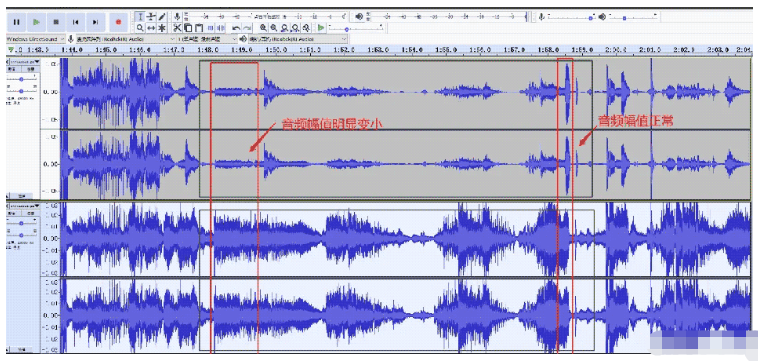
所以便可以确认在音频数据经过 hal 层音效处理前是正常等,经过音效处理后,在某些特殊的声音数据下,音效库缩小了声音的幅值,从而导致声音的异常。
为了实锤是音效库 so 导致的问题,通过关闭音效库的功能,最终发现声音忽大忽小的问题消失了。
从以上尝试的结果综合分析可以确认,是音效 so 库对通道声音进行处理时影响到了原有声音的功能。通过修改 so 库最终来解决这个问题。
有用户反馈说是打开应用A播放视频正常,然后直接返回到 home 目录,应用A后台播放时会出现断音的现象。
声音卡顿,录音掉帧类的现象在声音问题中非常常见。从现象上来看,就是用户切换到后台时没有暂停播放,视频在后台播放时出现。老规矩,我们先分析相关 log,通过日志分析发现,当问题出现时,日志上频繁打印 get null buffer 的信息。
所以怀疑是否是音频数据丢失导致的。dump 音频数据抓取到系统混音后输出到输出设备的原始音频,可以帮助实锤上层系统传下来的数据是否正常。于是发现位置3的音频如下:
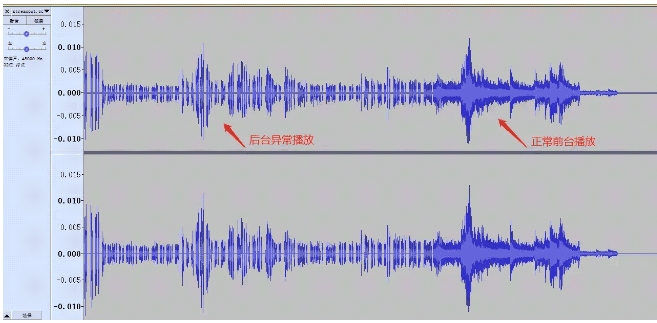
从抓取到的音频可以看到,在后台异常播放时,在该时间段内会出现明显音频丢帧的现象。接下来要看看是在哪一块出现了丢帧。进一步分析 audioTrack 传下来的数据,出现了丢失掉一部分音频的现象,时长相当于原音频的一半。
基于此,为了实锤是应用A传下来的数据就有缺失,从日志信息跟踪,决定在 audioTrack 上加日志信息来看,发现当切换到后台时,audioTrack 每次还是写 4096 个 byte ,但是写数据的频率降低了一半。   
正常:28.600-27.546=1.054 44次 间隔 1.054/43= 0.0245秒/次。   
异常:40.839-39.804=1.035 22次 间隔 1.035/21= 0.0493秒/次。
考虑到这一块是否是和后台进程的优先级相关。当进程降低时导致了写数据的线程能够拿到的CPU资源变小,出现了断音的问题。通过和其他型号的平板对比发现,各厂家 Android 10 的平板大部分均有此问题,而 android7 和 android 8 的平板就没有这个问题。基于以上情况,更加怀疑是和 android 的特性相关,可能是新的 android 平板针对后台线程优先级做了处理,目的也很明确,就是限制后台应用的活跃程度,来保证设备性能。
此时进一步分析最终发现是和 TimerSlackHigh 的参数相关。
system/core/libprocessgroup/profiles/task_profiles.json:
{
"Name": "TimerSlackHigh",
"Actions": [
{
"Name": "SetTimerSlack",
"Params":
{
"Slack": "40000000"
}
}
]
},
{
"Name": "TimerSlackNormal",
"Actions": [
{
"Name": "SetTimerSlack",
"Params":
{
"Slack": "50000"
}
}
]
},该参数影响了应用后台线程 sleep/wait 之间所消耗的时间。可以看到,当应用从前台切换到后台时,这个时间从50 微秒上调到 40 毫秒。从而导致写入音频数据量大大减少。通过修改参数可以解决,但是提高后台线程的活跃度,很可能影响到整体性能,因此不作处理。最终像用户解释,切换后台时可以手动停止播放视频,同时反馈给应用,由应用规范应用流程,起后台进程来做单独处理。
关于“Android audio音频流数据异常问题怎么解决”的内容就介绍到这里了,感谢大家的阅读。如果想了解更多行业相关的知识,可以关注亿速云行业资讯频道,小编每天都会为大家更新不同的知识点。
亿速云「云服务器」,即开即用、新一代英特尔至强铂金CPU、三副本存储NVMe SSD云盘,价格低至29元/月。点击查看>>
免责声明:本站发布的内容(图片、视频和文字)以原创、转载和分享为主,文章观点不代表本网站立场,如果涉及侵权请联系站长邮箱:is@yisu.com进行举报,并提供相关证据,一经查实,将立刻删除涉嫌侵权内容。